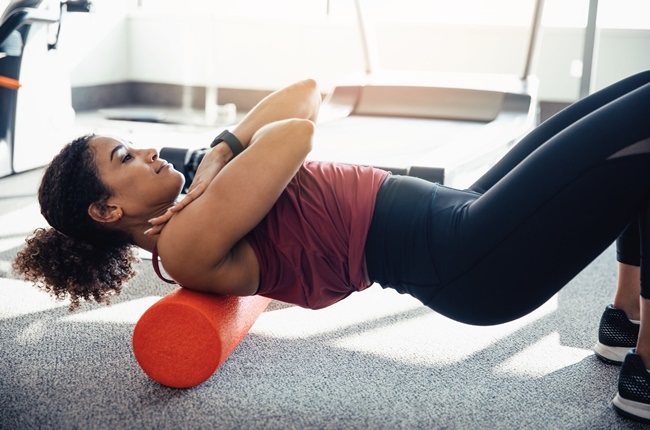We see foam rolling like flossing (as in, your teeth). It’s not necessarily something you want to do regularly, but it can make a huge difference if you do. In the case of foam rolling (which you can also call ‘self-myofascial release’ if you want to be fancy), there’s plenty of research on its benefits, but we’re going to give you a summary.
Spoiler alert: it works, and there are several reasons why, but one of the most important is it because it helps smooth away any issues in your fascia, which is the layer of connective and supportive tissue around your body. Not only does a foam roller help to improve the flexibility of your muscle tissue and tendons, but it can also target hard-to-reach places to break down knots (known as adhesions) in your muscles and fascia and tight scar tissue.
By using your body weight in foam rolling, you can perform self-massage, trigger-point therapy, and increase blood flow throughout your body. Here’s why that blue roller is your saviour, not a torture tool:
1. It will help with stiffness and DOMS (and your heart)
This is arguably the most important, as no one likes to be stiff, especially after getting back into training or after a particularly taxing leg-day session. One of the proven benefits of foam rolling is faster recovery and increased circulation (and, crucially, less delayed pain).
A study published in the Journal of Strength & Conditioning Research also found that the firm pressure and movement in foam rolling can improve your artery function!
2. It can help you sidestep injuries
Yip, it’s been proven to help prevent common injuries, especially those related to exercise. A good example: runners get pain along their iliotibial (IT) band if they don’t stretch regularly or use a foam roller to stop build-ups in the fascia or knots in the band.
Another common one: if desk-bound workers don’t stretch and roll out their hip flexors, they can become too tight from all the sitting and start causing major back pain.
3. It can save you moola
Masseurs and sports therapists don’t come cheap, while a foam roller does. Use this roller to perform some DIY panel beating at home. If you need some guidance with the exercises, check here. It can also help speed up injury rehab and cut down physio costs.
4. Foam rolling will boost your performance.
Here’s where it gets complicated and geeky and focused on hard-to-understand things like ‘elastic energy’, but bottom line: the more stretch a muscle gets, the more stored energy it has, the more force it will be able to generate.
The other big benefit is this: you’ll have a better range of motion in your training and your body will be primed and warmed up, which means you’ll most likely have better technique and power. On the other hand, a less flexible muscle produces less stretch, less range of motion, less stored energy, and decreased force output.
Which, as you can imagine, are all things you don’t want.
This article was originally published on The Movement Empire (TME).




 Publications
Publications
 Partners
Partners
















